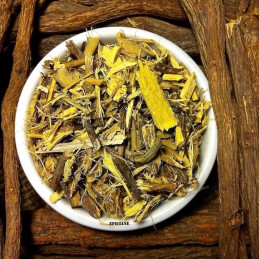
Reference: 108017302


Its enveloping and persistent taste is both mildly bitter and sweet at the same time.
You can infuse it to flavor beverages, ice creams, and pastries.
 Delivery
Delivery
Mondial Relay
 Returns
Returns
See conditions
 Payments
Payments
100% secure
Produit livré en sachet refermable
°°°
Uses in Cooking:
The small pieces of chopped licorice, ranging from a few millimeters to about 1 cm, are perfect for infusing, making them ideal for preparing drinks.
Licorice is widely used in herbal medicine, confectionery, and beverage production. Its flavor is a curious blend of sweetness, slight bitterness, and a sugary sensation. It pairs well with vanilla, mint, honey, caramel, and even coconut.
When chopped like this, licorice is ideal for infusion, making it perfect for crafting drinks. Pastis and its non-alcoholic counterparts contain a high proportion of licorice. Some even make homemade pastis by macerating licorice and other spices in alcohol with added sugar. This drink is delicious and completely natural, though its alcohol content calls for moderation.
Licorice is a delight when added to tea or mint infusions, and it can also enhance the flavor of medicinal herbal teas that can sometimes be hard to drink.
You can also macerate licorice in the cooking juices of certain white meats like chicken or guinea fowl. It can even be used in jams, such as melon jam, by placing the licorice in a tea bag or cheesecloth to make removal easier.
Who am I?
Origin: Turkey
Scientific name: Glycyrrhiza glabra
Common names: Licorice, sweetwood, caliche (in Belgium), reegalisse
Licorice refers to both the plant and its roots. For the roots, both masculine and feminine forms are used, although the plant itself is always feminine.
Licorice is a perennial herb from the Fabaceae family, growing in bushes between 1 and 1.5 meters tall. The aromatic roots, in the form of rhizomes, are consumed. The plant has light green leaves resembling those of acacias, and produces small blue to violet flowers in upright clusters. The fruit is a small, flat pod, 2 to 3 cm long, containing numerous seeds. Licorice is native to southern Europe.
It grows in rich, moist soils and thrives in warm climates, such as those found in the Mediterranean, southern U.S., the Middle East, and North Africa, where it was introduced long ago. When the plant thrives, it can become quite invasive, much like a weed—just one root fragment left in the soil can grow into a new plant!
Many people chew licorice sticks, especially children, but also those trying to quit smoking. Chewing on a licorice stick, especially in winter, can be an excellent protection against common respiratory infections during that season!
Licorice is also tonic, digestive, and soothing for the throat.
However, caution is advised: some of its active ingredients can raise blood pressure, cause edema, and lower potassium levels in the body. Excessive daily consumption of licorice can lead to serious health issues, and it is strongly discouraged for people with hypertension.
A Little History:
Licorice was known to the ancient Greeks and Romans, who used it to clear the voice, and it seems even the pharaohs appreciated it.
In the 13th century in Montpellier, a small candy called "grisette" was created by combining licorice and honey. It was around this time that licorice began to be cultivated around the Mediterranean, whereas it had previously only been wild. Later, it was combined with roasted couch grass root to make a drink called "hospitalière," often found on hospital bedside tables.
In the 15th century, after Jacques Coeur brought gum arabic from the Orient, which led to the invention of chewing gum, licorice began to flavor these confections, which would later be called "bonbons."
By the 18th century, the "coco" trend emerged in Paris, a drink made from licorice macerated in lemon water. It was sold on every street corner. Around the same time, people were consuming "cachous," a mix of licorice and areca nut, a mild stimulant. Napoleon Bonaparte reportedly became addicted to licorice after consuming it excessively.
Data sheet
 Andre N.
Andre N.
Pas encore testé

 Andre N.
Andre N.
Pas encore testé

Reference: 108017302
Reference: 00022475-0001
Reference: 6N7456401
Reference: verveine
Reference: 050721
Reference: 10N7738802
Reference: 10M6821604
Reference: cardamomeverteE
Reference: 3N7137901
Reference: bergamote
Reference: 3913
Reference: 00033929-0001
Reference: 26545D
Reference: SPW06600
Reference: baiepassion
Reference: 1N7004306
Reference: badianeE
Reference: EPI230204

Its enveloping and persistent taste is both mildly bitter and sweet at the same time.
You can infuse it to flavor beverages, ice creams, and pastries.